Version 8 “PM8” is the latest major release of the ProMaster MasterKeying software family. It is a 100% redevelopment and supersedes version 7 “PM7”.
PM7 has been around for over 15 years, and in that time has had hundreds of updates to add features and design modules. PM7 is based on older technologies internally that don’t allow the product to grow, which don’t allow performance benefits from modern servers, and which don’t allow user interface design to be matched to modern Windows appearance. A fundamental requirement of being dominant in the provision of master keying software is to ensure that we have a long-term plan in place to meet customer expectations of stability and longevity.
The look and feel
The user interface has been designed to be crisp and clean, with use of images for task identification and consistency of style and wording. Reports also have been redesigned to provide a sharp modern appearance.

Choices remembered
In many search and data entry screens, choices you make are remembered and automatically set next time you visit the same screen, making PM8 automatically adjust to the way you work
Searching
Many screens where you search for data are beefed up with more items that you can search for. For example, when opening a system, you can search by signatory name.
Data capacity
With few exceptions, add data fields are significantly larger than in PM7. All fields can now store data from any language (The data is Unicode compliant).
New data fields
Various data fields have been added to give greater flexibility. Examples are Doors: stage, height, width, thickness; Keys: part code; Client: code, second contact, second phone, email etc; System: second contact, design notes; Job: sales order, customer code.
Door external and internal keying
Doors may now be flagged as having different keying for an internal cylinder and then keying and corresponding calculations are performed for both the external and the internal cylinder.
Keying matrix
Highlight door/key search, much-improved mouse control, indicators for where keying has changed, indicators for same stamping, indicators for missing keying, more fine-grained propagation control.
Various ways to filter the view shown including by key or door group, hiding masters, from a search of keys or doors, showing by stamping and a non-editable view where only the first door for each unique stamping is shown (This is very useful when coding complex systems, and is an option for the keying matrix report also). As well as horizontal, vertical and diagonal lines of keying, you can now also select a rectangular block and set or remove the keying for that selection in a single operation. Assign all to a key, assign all to a door, and undo for keys and doors.
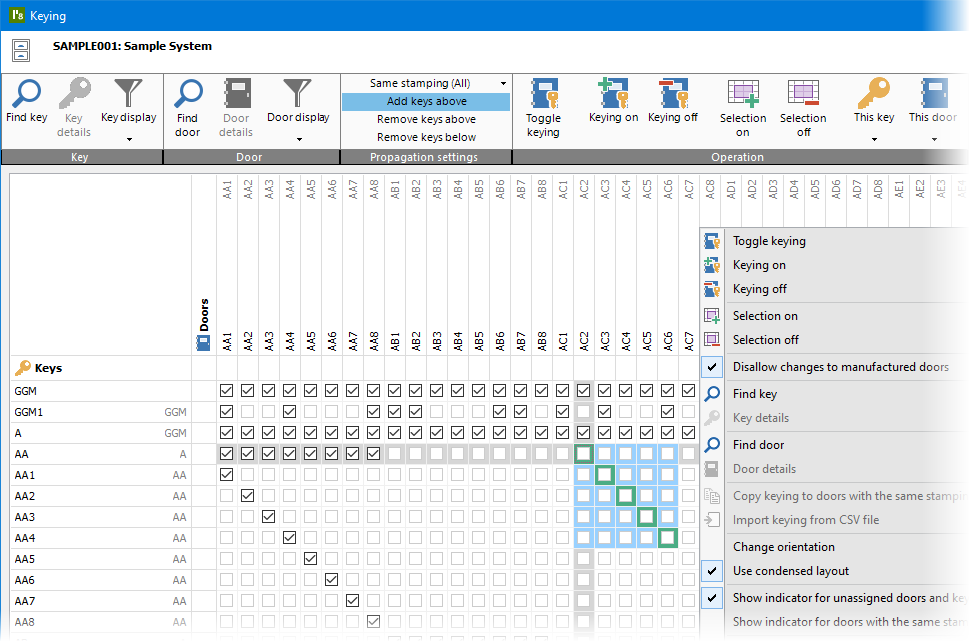
Security
Security has been moved from a user-by-user basis to security groups. Each user belongs to a security group and the security group controls permissions and system access through security categories. This allows for much easier control when there are more than a handful of users.
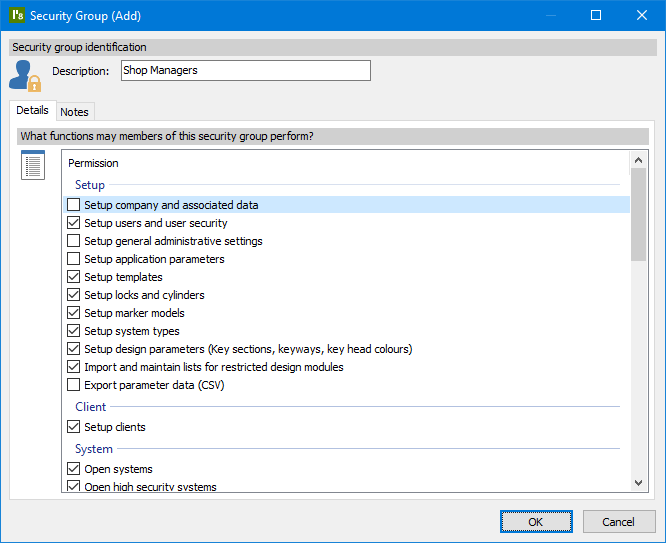
SMTP email has been enhanced to use secure SMTP (e.g. if you use Office 365) and to use rich text for the email instead of plain text.
Client signatories
Signatories have been introduced at the client level, and these are linked to appropriate systems for that client, making management of the signatories easier and making the client signatories readily available for new systems.
System snapshots
System snapshots effectively make a 100% copy of the system and make it a non-editable backup. Great for providing security before making changes that may later be unrequired and for backing up a system before undertaking complex coding changes.

Excel export and import
The Excel export and import now uses the latest xlsx file format with enough columns for thousands of keys without needing to use multiple pages. Multiple spreadsheet layouts can be accommodated through a simple editor that allows you to define alternative spreadsheet layouts.
An installation of Excel is no longer required to be able to export and import to the spreadsheet format, and a nice side benefit of this is that the spreadsheet reading, and writing is now a huge amount faster.
System types
System type configuration has been significantly enhanced, now encompassing many settings that were previously global to each design module and tucked away in the application parameters.
As a result of the system type setup and in other areas “on-the-fly” choices, the number of application parameters has been reduced to just the essentials making them easier to navigate.
Manufacturing
A significant redesign to the job manufacturing interface gives many more options and makes it much easier to perform a single task (e.g. Preview a single report or send data to a machine) without having to deselect other choices.
The on-screen pinning is revamped to be crisper and cleaner with improved navigation and bookmarks.
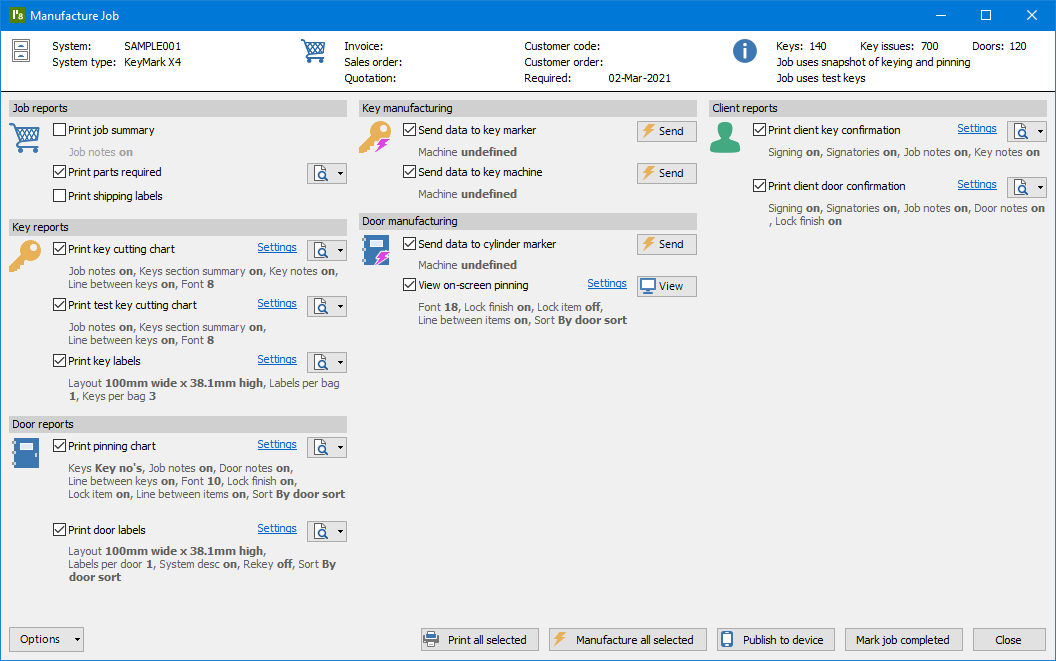
Machines
The manufacturing interface has been redesigned to give more options when downloading to machines, including the ability on many machines to batch download the job in sections.
Support is added for the Silca Futura and the Miracle for standard keys.
The setup for machines has been simplified and unified into a single screen that is accessible from several areas of the program.
Coding
Significantly faster loading of the coding tree on huge systems.
Progressions are sortable and have notes attached to each progression. The progression editor is dramatically enhanced.
Special pinning is available on most design modules, and where appropriate there is the capability to say that a chamber in the cylinder is to be left empty (resulting in empty pinning, altered phantom checking, altered outputs for pinning, on-screen pinning and XML).
Design notes (with rich text) are available to document the design, and both system notes and design notes are accessible while coding.
Key codes and door pinning reports are available from within the coding screens to allow immediate checking of the coding solution.
On the coding matrix there is a feature that highlights codes below the selected code – useful for understanding a huge coding matrix.
The keying matrix what is available in the coding screens is enhanced, and the full keying matrix can be opened while coding and moved to a second monitor to assist while coding cross keyed systems.
Significant enhancements to the coding for all Kaba modules.
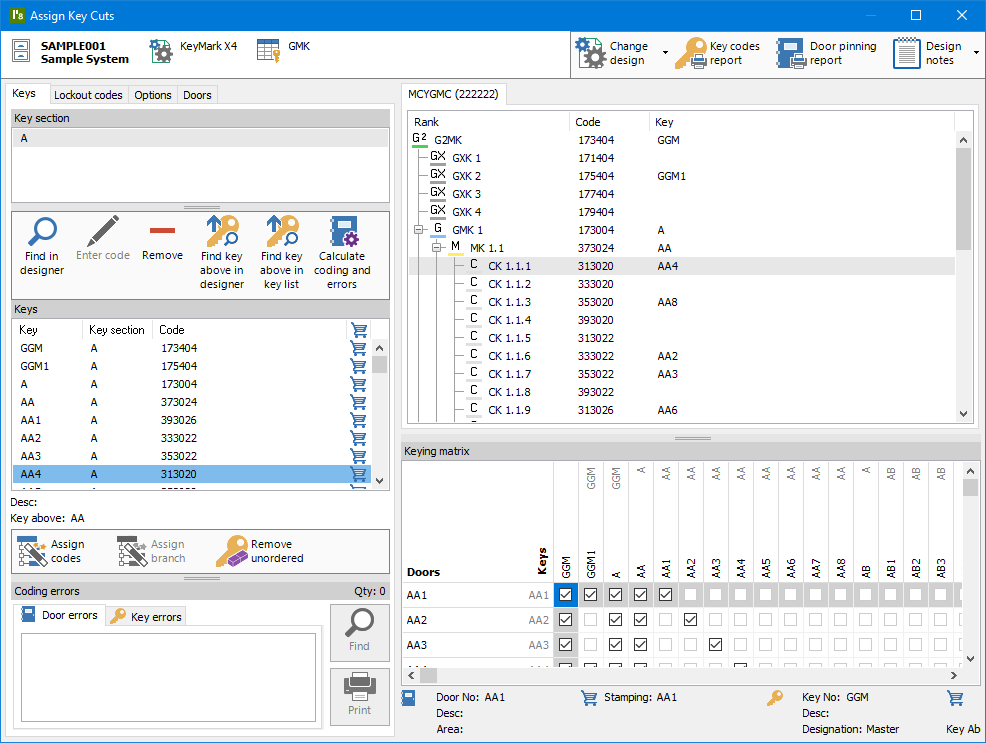
Key hierarchy
The key hierarchy display allows you to drag keys around to change the key above, and the key hierarchy can be printed prior to committing changes.
Alerts
Alerts can be attached to a system and they appear when you have the system open. Continual alerts and alerts that appear on a date are supported.
Key sections
Key sections and keyways are consistent across design modules with a unified editor for defining key section families, including longer key section and keyway names and sorting.
Signature registration form
The text that appears on the signature registration form is customisable and supports rich text.
Exports and imports
Most configuration information such as clients, locks, cylinders can be exported and imported via csv files.
Branch addresses
Multiple addresses for your company may be defined and users may be associated with a branch address. This controls the information printed in the report headers.
Door signatories
Quantity of signatories required for each door, and individual door signatories may be specified, just like for keys.
Report header graphics
There are now three options for report headers –text, text with small logo graphic and full width logo graphic.
Rich text
Pretty much everywhere notes are stored they are now implemented as rich text allowing better layout and emphasis of important points.
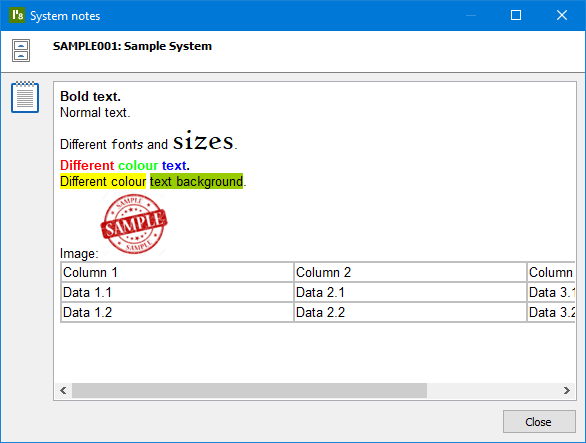
Key and door groups
Key and door group implementation is greatly improved making it much easier to manage and use key and door groups.
Label layout editor
Various door and key label layouts are provided as standard and using the label layout editor you can make your own label layouts. If you need a different label size, make a new layout yourself in minutes.
Data locking
To stop users accidentally editing data that another user is changing, a locking system is introduced to ensure exclusive access to any system and common data you are editing.
Setup permissions
Most setup functions can be performed by users with appropriate permissions removing the need to log in as admin to make these changes.
The database
The database underpinning PM8 is Firebird 3, many years and many versions more modern that that used by PM7.
What does this mean?
It is more robust. It performs better. It uses modern server hardware better, including multiple CPUs to provide better performance. It removes all known vulnerabilities present in the older database engine. It provides data encryption for the data being transferred across the network protecting your data from malicious attack.